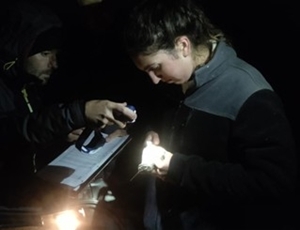By Rosa Hicks, Predation Scientist
 The great snipe (Gallinago media) is a bird steeped in both history and mystery, captivating hunters and ornithologists alike for centuries. You may be familiar with anecdotes of great snipe (sometimes called the solitary snipe or double snipe), with tales of hunted snipe as big as woodcock passed through the countryside for generations.
The great snipe (Gallinago media) is a bird steeped in both history and mystery, captivating hunters and ornithologists alike for centuries. You may be familiar with anecdotes of great snipe (sometimes called the solitary snipe or double snipe), with tales of hunted snipe as big as woodcock passed through the countryside for generations.
However, since the mid-1900s, global great snipe populations have faced steep declines due to habitat loss from wetland drainage and agricultural expansion, and unsustainable hunting on both their Siberian breeding grounds and Sub-Saharan African wintering grounds. Last summer, I had the opportunity to help with the monitoring of passage great snipe in Denmark, gaining firsthand insight into the challenges of studying and conserving such a cryptic species.
The great snipe is a true marvel of migration, breeding in wetlands of Northern Europe and Russia before embarking on non-stop flights of up to 7,000km to Sub-Saharan Africa. During these flights, great snipe have been recorded reaching speeds of up to 97km/h, placing them among the fastest migratory species on the planet. To fuel these intrepid journeys, western populations of great snipe stop off in Scandinavia and the Baltics, feeding intensely to build large fat reserves that allow them to lose up to half their body weight during migration. Occasionally, birds overshoot westward to the UK, an occurrence documented in historical gamebag records.
Great snipe were once a prized quarry species across Europe. Their visual similarity to common snipe and Eurasian woodcock, exceptional camouflage, tendency to sit tight in dense vegetation, and swift zig-zagging flight presented the ultimate test of skill among hunters. British gamebag records suggest they were once regular visitors, with several hunted annually during the 19th and early 20th centuries. However, by the mid-20th century, their numbers had dwindled – a trend documented throughout Europe. As a result, the great snipe was removed as a quarry species in all European countries, shifting the focus to population remediation.
 Autumn migration routes from 22 males GPS tagged from a Swedish breeding population.
Autumn migration routes from 22 males GPS tagged from a Swedish breeding population.
Note the absence of stop overs across Southern Europe and Northern Africa! (Lindström et al, 2016)
A licensed team from northern Denmark is contributing to global datasets by surveying, catching, and ringing great snipe during the brief autumn pre-migration stopover of western breeders. We identified potential stopover habitats and conducted daylight transects, monitoring common snipe numbers in search of their elusive relatives. Local birders contributed valuable observations of great snipe presence and absence, leading us to a handful of unassuming stubble fields southwest of Aalborg in the middle of the night.
To catch great snipe, a thermal imager was used to spot them, and a torch and large hand net to catch them. The process required complete silence and patience, as the birds were easily spooked. Eventually, with others in the team bringing plenty of luck - and me bringing a little woodcock hand-netting experience - we successfully caught and ringed an adult and juvenile.
With only 28 great snipe ever ringed as part of the Danish national bird-ringing scheme, and 26 of those since targeted efforts began in 2007, data from every individual is invaluable. Recaptures of ringed birds offer insights into migratory routes, and the brief process of capture allows for pre-migration biometrics such as body weight and fat reserves to be recorded. Additionally, information from the transects walked and birds observed by all contributors was reported to the Danish Ornithological Society and local landowners, helping to guide future conservation efforts.


Photo: Skagen Fuglestation
So, what does the future hold for the great snipe?
The great snipe is classified as a Species of European Conservation Concern (SPEC), defined by a population of over 10,000 breeding pairs but experiencing large population decline. While the most pronounced declines are apparent in the western breeding populations, there is no good estimate of total population. Surveys of lekking males are ongoing and provide the best estimates of breeding pairs, but the inaccessibility of wetland breeding habitats and fragmented transnational populations complicate global conservation efforts.
The great snipe serves as a poignant reminder of the delicate balance of the natural world. Through international collaboration of wildlife workers, we can deepen our understanding of great snipe biology and ensure that this enigmatic species and its remarkable migrations remain a part of our shared natural heritage.